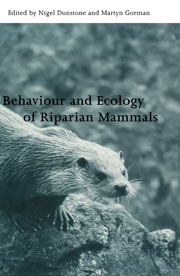Book contents
- Frontmatter
- Contents
- List of contributors
- Preface
- 1 Adaptations to the semi-aquatic habit and habitat
- 2 Physiological challenges in semi-aquatic mammals: swimming against the energetic tide
- 3 Diving capacity and foraging behaviour of the water shrew (Neomys fodiens)
- 4 Habitat use by water shrews, the smallest of amphibious mammals
- 5 The importance of the riparian environment as a habitat for British bats
- 6 A preliminary study of the behaviour of the European mink Mustela lutreola in Spain, by means of radiotracking
- 7 The demography of European otters Lutra lutra
- 8 Habitat use and conservation of otters (Lutra lutra) in Britain: a review
- 9 The relationship between riverbank habitat and prey availability and the distribution of otter (Lutra lutra) signs: an analysis using a geographical information system
- 10 Influence of altitude on the distribution, abundance and ecology of the otter (Lutra lutra)
- 11 Diets of semi-aquatic carnivores in northern Belarus, with implications for population changes
- 12 Otter (Lutra lutra) prey selection in relation to fish abundance and community structure in two different freshwater habitats
- 13 Diet, foraging behaviour and coexistence of African otters and the water mongoose
- 14 Feeding ecology of the smooth-coated otter Lutra perspicillata in the National Chambal Sanctuary, India
- 15 Population trends of hippopotami in the rivers of the Kruger National Park, South Africa
- 16 Reproductive strategies of female capybaras: dry-season gestation
- 17 The continuing decline of the European mink Mustela lutreola: evidence for the intraguild aggression hypothesis
- 18 Otters and pollution in Spain
- 19 The rapid impact of resident American mink on water voles: case studies in lowland England
- 20 Status, habitat use and conservation of giant otter in Peru
- Index
2 - Physiological challenges in semi-aquatic mammals: swimming against the energetic tide
Published online by Cambridge University Press: 03 May 2010
- Frontmatter
- Contents
- List of contributors
- Preface
- 1 Adaptations to the semi-aquatic habit and habitat
- 2 Physiological challenges in semi-aquatic mammals: swimming against the energetic tide
- 3 Diving capacity and foraging behaviour of the water shrew (Neomys fodiens)
- 4 Habitat use by water shrews, the smallest of amphibious mammals
- 5 The importance of the riparian environment as a habitat for British bats
- 6 A preliminary study of the behaviour of the European mink Mustela lutreola in Spain, by means of radiotracking
- 7 The demography of European otters Lutra lutra
- 8 Habitat use and conservation of otters (Lutra lutra) in Britain: a review
- 9 The relationship between riverbank habitat and prey availability and the distribution of otter (Lutra lutra) signs: an analysis using a geographical information system
- 10 Influence of altitude on the distribution, abundance and ecology of the otter (Lutra lutra)
- 11 Diets of semi-aquatic carnivores in northern Belarus, with implications for population changes
- 12 Otter (Lutra lutra) prey selection in relation to fish abundance and community structure in two different freshwater habitats
- 13 Diet, foraging behaviour and coexistence of African otters and the water mongoose
- 14 Feeding ecology of the smooth-coated otter Lutra perspicillata in the National Chambal Sanctuary, India
- 15 Population trends of hippopotami in the rivers of the Kruger National Park, South Africa
- 16 Reproductive strategies of female capybaras: dry-season gestation
- 17 The continuing decline of the European mink Mustela lutreola: evidence for the intraguild aggression hypothesis
- 18 Otters and pollution in Spain
- 19 The rapid impact of resident American mink on water voles: case studies in lowland England
- 20 Status, habitat use and conservation of giant otter in Peru
- Index
Summary
Introduction
Foraging in both terrestrial and aquatic habitats exposes secondarily aquatic mammals to a range of environmental conditions not usually encountered by mammalian specialists. This is due in part to the very different physical properties of air and water. Depending on temperature and salinity, the density of water approximates 800 times that of air and its viscosity is nearly 60 times that of air. The heat capacity of water is approximately 3500 times higher than air and its heat conductivity 24 times greater. Consequences of these physical properties are different locomotor and thermoregulatory demands for runners and swimmers (Dejours, 1987). Remarkably, semi–aquatic mammals have maintained lifestyles that require locomotor and thermoregulatory proficiency in these two disparate environments.
Morphological specialization is one obvious way in which mammals have responded to the challenges presented by terrestrial and aquatic environments. Several notable trends include body streamlining and enlargement of the propulsive surfaces in animals specialized for aquatic locomotion (Fish, 1993). Comparison of terrestrial, semi–aquatic and marine mammals (Fig. 2.1) shows that both features change in a predictable manner. Fineness ratio, an index of body streamlining (Hertel, 1966; Webb, 1975), approaches the optimum value of 4.5 as we move from secondarily aquatic mammals to obligate marine mammals (Fish, 1993; see Fig. 2.1). Many obligate aquatic mammals also show a reduction in limb length and expansion of the propulsive surface area. In contrast, modification of the appendages of semi–aquatic mammals may be limited by the dual role they must serve.
- Type
- Chapter
- Information
- Behaviour and Ecology of Riparian Mammals , pp. 17 - 30Publisher: Cambridge University PressPrint publication year: 1998
- 8
- Cited by



